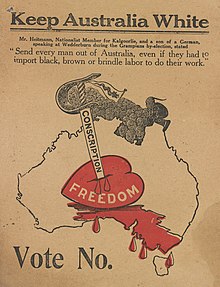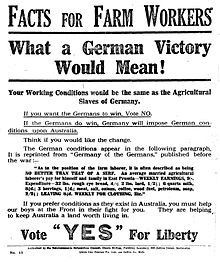| ||||||||||||||||||||||
| Are you in favour of the proposal of the Commonwealth Government for reinforcing the Australian Imperial Force oversea? | ||||||||||||||||||||||
| Results | ||||||||||||||||||||||
|---|---|---|---|---|---|---|---|---|---|---|---|---|---|---|---|---|---|---|---|---|---|---|
| ||||||||||||||||||||||
 Results by state. Results by state.
| ||||||||||||||||||||||
The 1917 Australian referendum was held on 20 December 1917. It contained one question.
- Are you in favour of the proposal of the Commonwealth Government for reinforcing the Australian Imperial Force oversea?

Background
Further information: World War I conscription in AustraliaThe 1917 plebiscite was held a year after the highly contentious 1916 conscription plebiscite. The 1916 plebiscite had resulted in a surprise "no" vote, with voters in Queensland, New South Wales and South Australia, as well as a majority of electors nationwide, rejecting the proposal. The political fallout was swift and, by November 1916, had led to the collapse of the First Hughes Ministry. That was associated with a split in the ruling Australian Labor Party, with Prime Minister Billy Hughes and some Labor MPs forming the breakaway National Labor Party which, by February 1917, had merged with the conservative Commonwealth Liberal Party to form the Nationalist Party of Australia. While the Nationalist Party was dominated by former Commonwealth Liberals, it retained Hughes as leader. After Hughes and the Nationalists scored a convincing victory at the 1917 election, Hughes announced that a second plebiscite on the question of conscription would be held on 20 December 1917.
During the course of World War 1, 38.7% of eligible Australian men enlisted for service — around 420,000 out of an eligible population of a little over 1 million. During the war, the range of men eligible to volunteer was expanded, with the initial age range of 19–38 expanded to 18–45 in June 1915. At the same time, medical standards were lowered. For example, by April 1917 the minimum height had dropped from 5 ft 6 in (168 cm) in August 1914 to 5 ft (152 cm). Despite that, there was a marked decrease in the number of enlistments after 1915, with the average in 1917 being fewer than 4,000 per month:
- 1914: 52,561
- 1915: 165,912
- 1916: 124,352
- 1917: 45,101
The 1917 plebiscite


The proposal for the 1917 plebiscite was less far-reaching than that of the 1916 poll, eschewing full conscription of able-bodied men and instead proposing to conscript men between the ages of 18 and 44 through a ballot system, and only in months where voluntary enlistments fell below 7,000 men.

The plebiscite was held due to the Australian Government's desire to increase the recruitment of forces for overseas service to a total of 7,000 men per month. It was conducted under the War Precautions (Military Service Referendum) Regulations 1917. It formed part of the larger debate on conscription in Australia throughout the war.
All of the historical documentation refers to the ballot as a referendum, even though it did not involve a proposal to amend the Australian Constitution. Because it was not an amendment to the constitution, (1) it had no legal force, (2) it did not require approval in a majority of states and (3) residents of federal territories were able to vote. Such a ballot is now usually referred to as a plebiscite to distinguish it from a referendum to alter the Constitution.
The campaign was notable for an incident in which a protester threw an egg at Prime Minister Hughes, in Warwick, Queensland, and for a raid on the Queensland Government Printing Office by Hughes, accompanied by a party of soldiers, who seized 3,300 copies of the Queensland Parliamentary Hansard which Hughes deemed to contain subversive anti-conscription speeches.
Results
Despite the fact that the 1917 plebiscite was less far-reaching than the 1916 one, the anti-conscription vote won by a larger margin than it had in 1916. Every state and territory was less supportive of conscription in 1917 than it had been in 1916 with the sole exception of South Australia, which had become more supportive of conscription (although a majority still opposed it).
| State | Electoral roll | Ballots issued | For | Against | Informal | ||
| Vote | % | Vote | % | ||||
| New South Wales | 1,055,883 | 853,894 | 341,256 | 41.16 | 487,774 | 58.84 | 24,864 |
|---|---|---|---|---|---|---|---|
| Victoria | 807,331 | 678,806 | 329,772 | 49.79 | 332,490 | 50.21 | 16,544 |
| Queensland | 378,378 | 310,164 | 132,771 | 44.02 | 168,875 | 55.98 | 8,518 |
| South Australia | 261,661 | 197,970 | 86,663 | 44.90 | 106,364 | 55.10 | 4,943 |
| Western Australia | 162,347 | 135,593 | 84,116 | 64.39 | 46,522 | 35.61 | 4,955 |
| Tasmania | 106,803 | 78,792 | 38,881 | 50.24 | 38,502 | 49.76 | 1,409 |
| Northern Territory and Federal Capital Territory | 4,037 | 3,002 | 1,700 | 58.22 | 1,220 | 41.78 | 82 |
| Total | 2,776,440 | 2,258,221* | 1,015,159 | 46.21 | 1,181,747 | 53.79 | 61,315 |
| Including 199,677 votes by members of the Australian Imperial Force, of which 103,789 were for, 93,910 against, and 1,978 informal. | |||||||
| Results | Obtained an overall minority of 166,588 votes. Not carried | ||||||
See also
Notes
- People in the territories were not able to vote at a referendum to alter the Constitution until after the 1977 referendum.
- As this was a plebiscite not a referendum to amend the Australian Constitution, there was no requirement for a majority of states.
References
- "The Question". The Daily Telegraph. 8 December 1917. p. 10.
- "A Quiet Polling Day". The Sydney Morning Herald. 21 December 1917. p. 7.
- Connor, John (2011). Anzac and Empire: George Foster Pearce and the Foundations of Australian Defence. Cambridge University Press. p. 107. ISBN 9781107009509.
- "Enlistment standards". Australian War Memorial. Archived from the original on 13 October 2016.
- "Enlistment statistics, First World War". Australian War Memorial. Archived from the original on 13 October 2016.
- A.G. Butler (1943). "Special problems and services: the official history of the Australian Army Medical Services in the war of 1914–1918, vol. III" (PDF). p. 889. Archived (PDF) from the original on 20 December 2016 – via Australian War Memorial.
- Carroll, Brian (2004). Australia's Prime Ministers: From Barton to Howard. Rosenberg Publishing. p. 93. ISBN 9781877058226.
- ^ "War Precautions (Military Service Referendum) Regulations 1917". Commonwealth of Australia. 10 November 1917. Archived from the original on 20 December 2016.
- "Conscription referendums, 1916 and 1917 – Fact sheet 161" (PDF). National Archives of Australia. Retrieved 3 February 2022.
- ^ Handbook of the 44th Parliament (2014) "Part 5 - Referendums and Plebiscites - Plebiscite results". Parliamentary Library of Australia. Archived from the original on 15 April 2018..
- "Senior Sergeant Kenny entirely exonerated". Warwick Examiner and Times. Qld. 5 December 1917. p. 4 – via National Library of Australia.
- Fitzgerald, Ross (1994). "Red Ted": The Life of E. G. Theodore. University of Queensland Press. p. 96. ISBN 9780702226496.
| Federal elections | |
|---|---|
| Constitutional Convention | |
| Referendums | |
| See also: By-elections | |